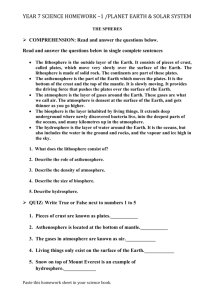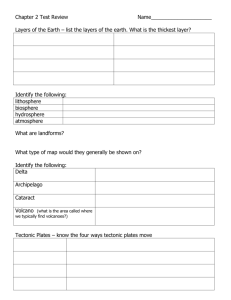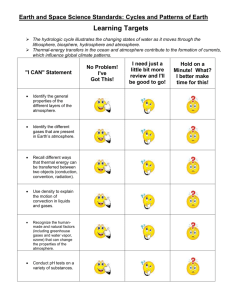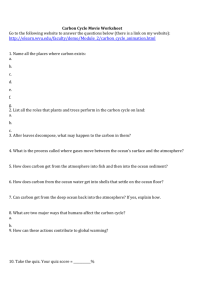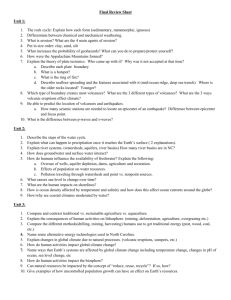Chapter 3 Written Notes
advertisement
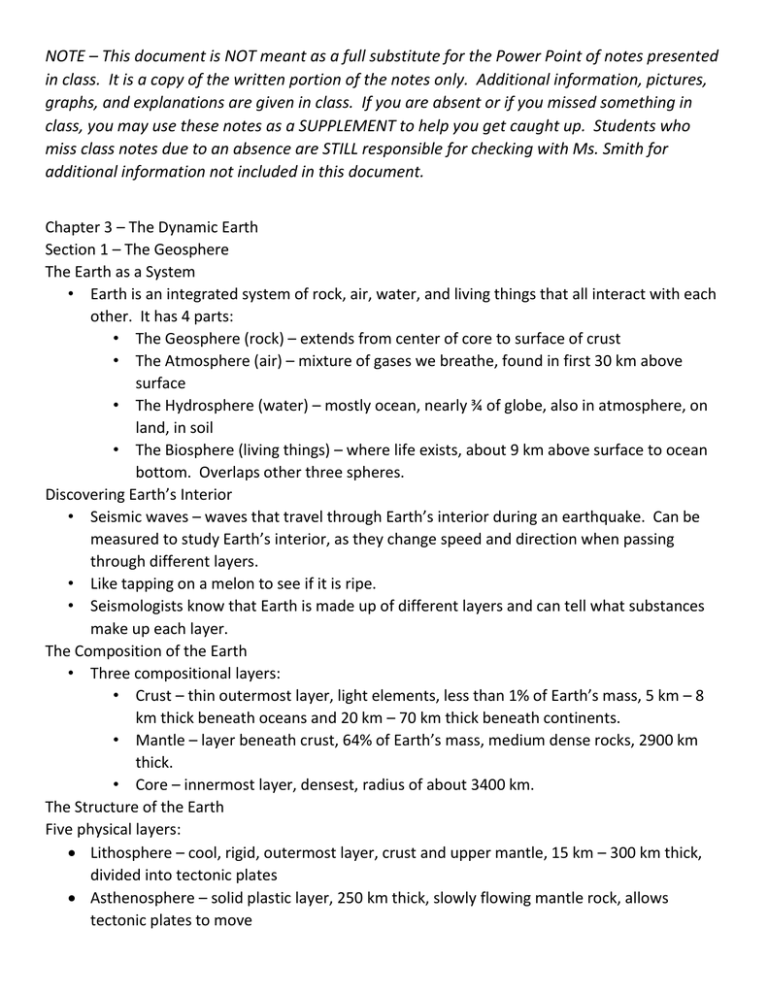
NOTE – This document is NOT meant as a full substitute for the Power Point of notes presented in class. It is a copy of the written portion of the notes only. Additional information, pictures, graphs, and explanations are given in class. If you are absent or if you missed something in class, you may use these notes as a SUPPLEMENT to help you get caught up. Students who miss class notes due to an absence are STILL responsible for checking with Ms. Smith for additional information not included in this document. Chapter 3 – The Dynamic Earth Section 1 – The Geosphere The Earth as a System • Earth is an integrated system of rock, air, water, and living things that all interact with each other. It has 4 parts: • The Geosphere (rock) – extends from center of core to surface of crust • The Atmosphere (air) – mixture of gases we breathe, found in first 30 km above surface • The Hydrosphere (water) – mostly ocean, nearly ¾ of globe, also in atmosphere, on land, in soil • The Biosphere (living things) – where life exists, about 9 km above surface to ocean bottom. Overlaps other three spheres. Discovering Earth’s Interior • Seismic waves – waves that travel through Earth’s interior during an earthquake. Can be measured to study Earth’s interior, as they change speed and direction when passing through different layers. • Like tapping on a melon to see if it is ripe. • Seismologists know that Earth is made up of different layers and can tell what substances make up each layer. The Composition of the Earth • Three compositional layers: • Crust – thin outermost layer, light elements, less than 1% of Earth’s mass, 5 km – 8 km thick beneath oceans and 20 km – 70 km thick beneath continents. • Mantle – layer beneath crust, 64% of Earth’s mass, medium dense rocks, 2900 km thick. • Core – innermost layer, densest, radius of about 3400 km. The Structure of the Earth Five physical layers: Lithosphere – cool, rigid, outermost layer, crust and upper mantle, 15 km – 300 km thick, divided into tectonic plates Asthenosphere – solid plastic layer, 250 km thick, slowly flowing mantle rock, allows tectonic plates to move • Mesosphere – “middle sphere”, 2550 km thick, lowest layer of mantle • Outer Core – outer shell of Earth’s core, 2200 km thick, liquid nickel and iron • Inner Core – center sphere of Earth’s core, 1228 km radius, solid nickel & iron Plate Tectonics • Tectonic plates – blocks of lithosphere that glide across underlying asthenosphere. Continents on top move with plates. Major plates include Pacific, North America, South America, Africa, Eurasian, Antarctic. • Plate Boundaries – where the action is found, plates can separate, collide, slip past one another. • Mountains – formed by colliding plates, pushing ground up. For example, Himalayan Mountain range is still growing. Everest grows about 4 mm each year. Earthquakes • Fault – break in Earth’s crust along which block of the crust slide relative to one another. • Earthquake – ground vibration, result of slippage along a fault, occur all the time, so small we don’t feel them, some very large, can cause widespread damage • Magnitude – measure of energy released by earthquake • Smallest felt is 2.0, greater than 7.0 = lots of damage • 1 whole number increase = 31.7 times more energy • Occur mostly at or near tectonic plate boundaries, most famous in US is San Andreas, along California coast. • Unpredictable times, mostly predictable places, can prepare by building earthquake resistant buildings, which are slightly flexible and can sway with the motion of the ground. Volcanoes • Mountain built from magma (melted rock) that rises from the Earth’s interior to its surface. • Often located near tectonic plate boundaries, majority along Pacific Ocean, known as “Ring of Fire” • Local Effects – clouds of hot ash, dust, gases, up to 200 km/hr, sear everything, ash can mix with water to form mudflows, ash can accumulate so heavily that it collapses buildings, buries crops, damages vehicle engines, makes it hard to breathe. • Global Effects – can change Earth’s climate for several years, ash and gases can reach upper atmosphere and globally reduce sunlight, which can drop average temps. Erosion • Process in which the materials of the Earth’s surface are loosened, dissolved, or worn away and transported from one place to another by a natural agent, such as wind, water, ice, or gravity. Makes rocks smoother, so older mountains are smoother than younger ones. • Water Erosion - both rivers and oceans, erode coastlines, carve deep gorges • Wind erosion - If there are few plants, like beaches and deserts, can blow soil away, also can erode soft rocks like sandstone more quickly than hard rocks, like granite. • Stone Mountain formed from an upwelling of magma that didn’t actually reach the Earth’s surface. Wind erosion eventually exposed the dome. Section 2 – The Atmosphere Composition of the atmosphere • Atmosphere – mixture of gases that surrounds Earth, including nitrogen (N₂), oxygen (O₂), carbon dioxide (CO₂), and other gases • Constantly changing – animals remove O₂ and add CO₂, plants add O₂ and remove CO₂, volcanoes add gases, vehicles add and remove, etc. • Insulation – prevents heat loss so living things survive • 78% N₂ (from volcanoes and decay), 21% O₂ (plants), other 1% is mix of argon, CO₂, methane, and water vapor. Also contains tiny particles, called atmospheric dust • Air pressure – atmosphere pulled by gravity, denser near Earth’s surface, less dense with elevation, harder to breathe on mountains Four Layers of the Atmosphere • Troposphere – lowest layer, temp drops as altitude increases, where we have weather, densest, to 18 km above Earth’s surface • Stratosphere – above troposphere, from 10 – 50 km above surface, temp rises as altitude increases, as ozone absorbs sun’s ultraviolet (UV) energy, which warms the air. Ozone – gas molecule of 3 oxygen atoms (O₃), almost all in stratosphere, reduces UV radiation that reaches Earth, good thing, as UV radiation damages living cells. • Mesosphere – above stratosphere to 80 km, coldest, as low as -93ᵒC. • Thermosphere – farthest from surface, N₂ and O₂ absorb solar radiation, temps above 2000ᵒC, but air is so thin that particles rarely collide, little heat transferred, wouldn’t feel hot to us. Atoms can become electrically charged, known as ions, so lower thermosphere is called ionosphere, what causes “northern lights” – aurora borealis near North Pole and “southern lights” – aurora australis near South Pole Energy in the Atmosphere • Radiation – energy transferred as electromagnetic (EM) waves, such as visible light and infrared (IR) waves. • Conduction – transfer of energy as heat moves through a material • Convection – movement of matter due to differences in density caused by temp. variations and can result in transfer of energy as heat Heating of the Atmosphere • Solar energy that reaches Earth is EM radiation – visible, IR, UV light. • Only about 2 billionths (.00000002%) of sun’s energy reaches Earth, still plenty. • Half of energy that enters atmosphere reaches Earth, other half is absorbed or reflected in atmosphere by clouds, gases, dust, etc. Some also radiated back by oceans and land, keeps Earth from getting hotter and hotter • Dark colors absorb more radiation than light colors, and more atmosphere means more filtering, why we get pretty sunsets, as the light reflection affects the colors of visible light we see Movement of Energy and the Greenhouse Effect • Convection current - of air is warmed by Earth’s surface, rises in atmosphere, begins to cool, becomes more dense than surrounding air, sinks, moves back to Earth’s surface, warmed by surface, becomes less dense, rises again, continuous cycle in circular motion • Greenhouse effect – warming of the surface and lower atmosphere of Earth, occurs when greenhouse gases (CO₂, water vapor, methane, and nitrous oxide) in the air absorb and reradiate IR radiation. Good thing in moderation, as Earth would be too cold for life without it. Example – car on a hot day • Too many greenhouse gases = too much greenhouse effect Section 3 – The Hydrosphere and Biosphere The Hydrosphere and Water Cycle • Hydrosphere – all water on or near Earth’s surface – oceans, lakes, rivers, wetlands, ice caps, in soil, in rock layers beneath surface, & clouds • Water cycle – continuous movement of water from ocean to atmosphere to land and back to ocean • Evaporation – change of a substance from liquid to gas, water continually evaporates from oceans, lakes, rivers, etc., mostly from oceans • Condensation – change of state from gas to liquid, water vapor condenses on dust particles, which forms clouds, combine and fall as rain • Precipitation – any form of water that falls to Earth, rain, sleet, snow, hail Earth’s Oceans • World Ocean – all of Earth’s oceans, which are actually connected, helps regulate planetary environment • Pacific Ocean – largest, surface area of about 165,640,000 km², deepest point in world – Challenger Deep, located east of Philippine Islands, at bottom of Mariana Trench, 11,033 m (almost 7 miles) below sea level , (Mount Everest is 8848 m, 5 ½ miles). Divided into North and South Pacific, based on direction of surface current flow. North of Equator – currents move clockwise, South – counterclockwise. • Atlantic Ocean – second largest, half size of Pacific, about 81,630,000 km², also divided into North and South. • Indian Ocean – third largest – 73,420,000 km². • Arctic Ocean – smallest – 14,350,000 km², much of surface covered by pack ice, forms when waves or wind drive together frozen sea water (sea ice) into a large mass. Ocean Water and Temp. Zones • Contains more salt than fresh water. Salinity – measure of amount of dissolved salts in given amount of liquid. Lower in places with a lot of rain or where fresh water flows into the sea. Higher where water evaporates rapidly and leaves salt behind. Mostly sodium chloride (NaCl), also includes potassium, calcium, sulfur, and magnesium. • Temperature zones – surface warmed by sun, bottom of ocean near freezing due to lack of sunlight. Warm surface zone up to 350 m deep, depending on waves and currents. Below surface zone is thermocline, 300 – 700 m deep, temps. fall rapidly. Deep zone – bottom layer, average temp of 2ᵒC. A Global Temperature Regulator • Major function – absorb and store energy from sunlight, which regulates temps in atmosphere. • Ocean absorbs and releases heat slower than land, so atmospheric temps change more slowly too. • Without this system, temps would be too extreme for life • Local temps also regulated by ocean as currents circulate warm water, moderates temps of nearby land areas, like Great Britain • Surface currents – streamlike movements of water near surface, wind driven, from global wind patterns, warm and cold currents don’t readily mix • Deep currents – streamlike movements of water near ocean floor, form when cold, dense water from poles sinks below warmer water, coldest called Antarctic Bottom Water, flows slowly northward Fresh Water, River Systems, and Ground Water • Fresh water – insignificant salt, less than 3% of all water, most is in icecaps and glaciers, rest is in rivers, lakes, streams, etc. • River system – network of streams that drains an area of land, contains all land drained by river, including main river and tributaries (streams and small rivers that flow into the larger river). • Groundwater – water in the ground, from rain and melting snow, less than 1% of all water, supplies us with drinking water, and agricultural and industrial needs. • Aquifer – rock layer that stores and allows the flow of groundwater The Biosphere • Part of Earth where life exists, about 11 km into ocean, about 9 km into atmosphere • Materials that organisms require must be recycled, aided by gravity, availability of those materials determines extent of biosphere • Near Earth’s surface, for sunlight, needed by plants to produce food, other organisms get energy from those plants and from algae • Most algae float on ocean, called phytoplankton. Energy Flow in the Biosphere • Energy used by organisms found in biosphere, must have constant supply, allows life to continue • When organism dies, body broken down, nutrients available for other organisms. • Closed system – energy enters and leaves system, matter does not. Earth is closed system, matter doesn’t leave, energy does, as energy from sun enters and heat leaves • Open system – both energy and matter enter and leave system. Earth was once open, as matter was added by comets and meteorites.
